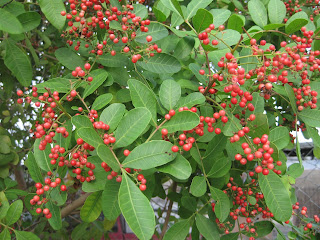Brazilian Peppertree
According to Wikipedia the description is as follows:
Brazilian peppertree is a sprawling shrub or small tree, with a shallow root system, reaching a height of 7–10 m. The branches can be upright, reclining, or nearly vine-like, all on the same plant. Its plastic morphology allows it to thrive in all kinds of ecosystems: from dunes to swamps, where it grows as a semiaquatic plant. The leaves are alternate, 10–22 cm long, pinnately compound with 5–15 leaflets; the leaflets are roughly oval, 3–6 cm long and 2–3.5 cm broad, and have finely toothed margins, an acute to rounded apex and yellowish veins. The leaf rachis between the leaflets is usually (but not invariably) slightly winged. The plant is dioecious, with small white flowers borne profusely in axillary clusters. The fruit is a drupe 4–5 mm diameter, carried in dense clusters of hundreds.
The two varieties are:
- S. terebinthifolius var. acutifolius, leaves to 22 cm, with 7–15 leaflets, fruit pink
- S. terebinthifolius var. terebinthifolius, leaves to 17 cm, with 5–13 leaflets, fruit red
Legal Status
The species, including the seed, is legally prohibited from sale, transport, or planting in Florida, according to the Florida Department of Agriculture and Consumer Services Noxious Weed List. It is classified as a Category I pest by The Florida Exotic Pest Plant Council (FL EPPC). To keep the plant from spreading into native plant communities and displacing them, local regulations and environmental guidelines require eradication of Brazilian pepper wherever possible. The plant and all parts are also illegal for sale or transfer in Texas. As one of the two species sold as pink peppercorn, the other being Schinus molle, it lacks generally recognized as safe (GRAS) status with the FDA.




No comments:
Post a Comment